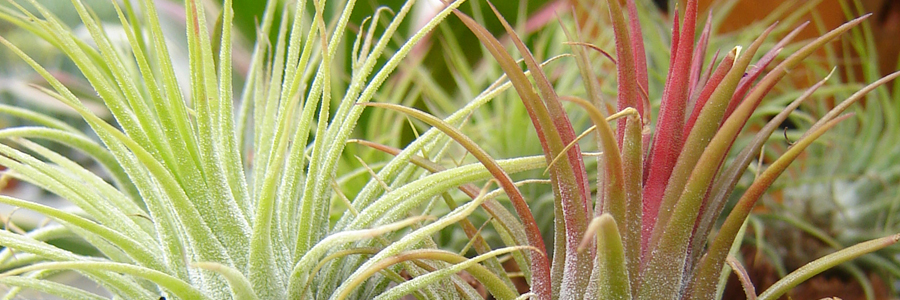






Air Plants – Tillandsia
Air Plants also go by the name of Tillandsia and require little care. During certain times in the season Tilliandsia features beautiful colorful leaves. Bright indirect light is best. Use distilled water to mist you plants. If located in kitchens or bathrooms, twice a week is recommended as the plant benefits from steam created in these areas. If placed in a dryer locale, misting is required on a more frequent basis.
A basic rule of thumb is to water them every time you water your other plants. In any area where the humidity is 50% or less it is difficult to overwater the plants unless it is very cold. Generally, the warmer and/or drier the air, the more frequently you will water. However, once Tillandsia leaves are wet, more water doesn’t do a thing for them. Wet them and leave them. This makes watering quick and efficient.
This is a little more critical than outdoors because one generally cannot use a hose so the watering has to be more precise. The most common mistreatment of tillys indoors, unintentional though it may be, is to under water them. Misting the plants CAN be sufficient but it can also be OVER-sufficient or UNDER sufficient. The plants can look dry but actually remain moist in the crucial center area, in the meristematic tissue where new cells are produced. If this area remains too moist for too long the plant may rot. Likewise, one can mist the plants regularly but, in the end, it isn’t enough to prevent a gradual dehydration that normally manifests itself with the edges of the leaves curling up and “pinching.”
The most secure way to water the plants indoors is to submerge them for a twelve hour period in “good” water, that is, water that is low in dissolved solids and salts. Rain water and bottled drinking water are the best. When the plants are under water for this length of time they have enough water availability for a long enough period of time to completely rehydrate. A soaking in this manner should suffice for ten days to two weeks in average conditions. If a mounting item is too big to submerge, attaching a velcro dot to the plant and the mounting item allows the plant to be easily removed so that it can be rehydrated. Finally, if this just isn’t practical or possible, mist the plants with “good” water and try to monitor the state of hydration as best you can. Once you have the right system down that works in your given situation, watering is a breeze.
On a final note, if the plants are soaked, you can put water in a container that has a lid to prevent evaporation. This water can then be used over and over for your soakings. A small pinch of Epiphyte’s Delight fertilizer in the water helps as well and it lasts indefinitely. Shake or jostle the container prior to putting the plants in, in order to remix the fertilizer evenly throughout the water. Also, as the water gets used, more can be added to keep the container full enough to submerge the plants completely.
Let the seedlings just grow. Treat them as the other plants. Light, air, space, water, maybe a little very diluted fertilizer once in a while.
Copyright © www.100flowers.win Botanic Garden All Rights Reserved